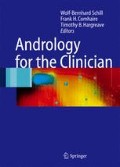Summary
The parasympathetic nervous system provides the primary pro-erectile innervation of the penis. Originating from the sacral nerve roots (S2–S4) the nerves provide vasodilating innervation to the cavernosal tissue. The parasympathetic nerves release a cocktail of pro-erectile neurotransmitters, of which the most important is nitric oxide (NO), which acts on the smooth muscle cell via a second messenger system involving cyclic GMP. The sympathetic innervation mediates detumescence and originates within the thoraco-lumbar cord (T11-L2) via release of noradrenaline. Our knowledge of the pharmacology of erection has recently provided us with a number of therapeutic approaches to the treatment of erectile dysfunction. The pudendal nerve represents the somatic innervation of the penis carrying both afferent impulses from the genitalia and motor fibres to the muscles of the pelvic floor.
The erection itself is a vascular event during which the degree of erection depends upon the balance between the arterial inflow and venous outflow of the penis. Parasympathetic stimulation (with an accompanying reduction in sympathetic stimulation) results in smooth muscle relaxation in the penile arteries, relaxation of the cavernosal (trabecular) smooth muscle and closure of the venous outflow from the penis.
Ejaculation has two phases, emission and ejection, the latter usually being accompanied by orgasm. Emission involves the sequential contraction of the epididymis, vas deferens, seminal vesicles and prostate, with ejaculatory fluid being “emitted” into the posterior urethra. Ejection is accompanied by tight closure of the bladder neck, with contraction of the prostatic musculature together with a sequence of variably coordinated contractions of the bulbocavernosus, ischiocavernosus and other pelvic floor muscles. The ejaculate is propelled into the anterior urethra and beyond.
The foreskin or the prepuce is a specialized, junctional mucocutaneous tissue that marks the boundary between mucosa and skin. It may have a number of functions including one as a sensory erogenous area and there may be others, but little is actually known.
Access this chapter
Tax calculation will be finalised at checkout
Purchases are for personal use only
Preview
Unable to display preview. Download preview PDF.
References
Cold CJ, Taylor JR (1999) The prepuce. BJU Int 83[Suppl 1]: 34–44
Giuliano F, Rampin O (2000) Central control of erection and its pharmacological modification. Curr Opin Urol 10:629–633
Lue TF, Takamura T, Schmidt RA, Palubishos AJ, Tanagho EA (1983) Hemodynamics of erection in the monkey. J Urol 128:1237–1241
McMahon CG, Abdo C, Hull E, Incrocci L, Levin R, Perelman M, Rowland D, Sipski M, Stuckey B, Waldinger M, ChengXin Z (2004) Disorders of orgasm and ejaculation in men. In: Lue TF, Basson R, Rosen R, Giuliano F, Khoury S, Montorsi F (eds) Sexual medicine: sexual dysfunctions in men and women. Editions 21, Paris, Chap. 13
Saenz de Tejada I, Angulo J, Cellek S, Gonzalez-Cadavid NF, Heaton J, Pickard R, Simonsen U (2004) Physiology of erectile function and pathophysiology of erectile dysfunction. In: Lue TF, Basson R, Rosen R, Giuliano F, Khoury S, Montorsi F (eds) Sexual medicine: sexual dysfunctions in men and women. Editions 21, Paris, Chap. 10
Tiihonen J, Kuikka J, Kupila J, Partanen K, Vainio P et al (1994) Increase in cerebral blood flow of right prefrontal cortex in man during orgasm. Neurosci Lett 170:241–243
Walsh PC, Donker PJ (1982) Impotence following radical prostatectomy: insight into aetiology and prevention. J Urol 128:492–496
Author information
Authors and Affiliations
Editor information
Editors and Affiliations
Rights and permissions
Copyright information
© 2006 Springer-Verlag Berlin Heidelberg
About this chapter
Cite this chapter
Baldo, O., Eardley, I. (2006). Physiology of Sexual Function. In: Schill, WB., Comhaire, F., Hargreave, T.B. (eds) Andrology for the Clinician. Springer, Berlin, Heidelberg . https://doi.org/10.1007/3-540-33713-X_59
Download citation
DOI: https://doi.org/10.1007/3-540-33713-X_59
Publisher Name: Springer, Berlin, Heidelberg
Print ISBN: 978-3-540-23171-4
Online ISBN: 978-3-540-33713-3
eBook Packages: MedicineMedicine (R0)

